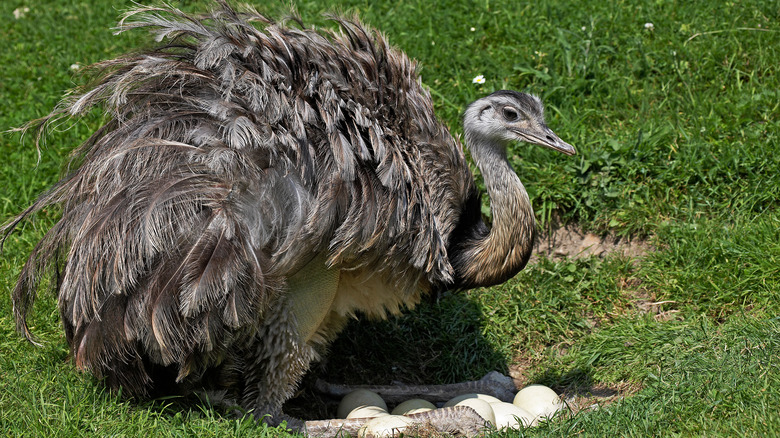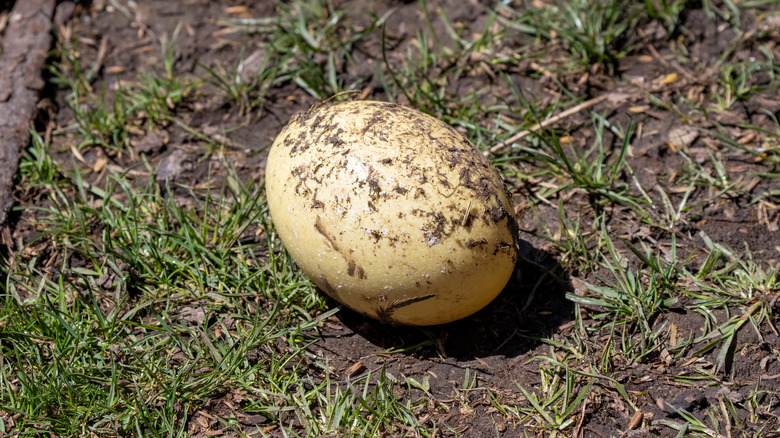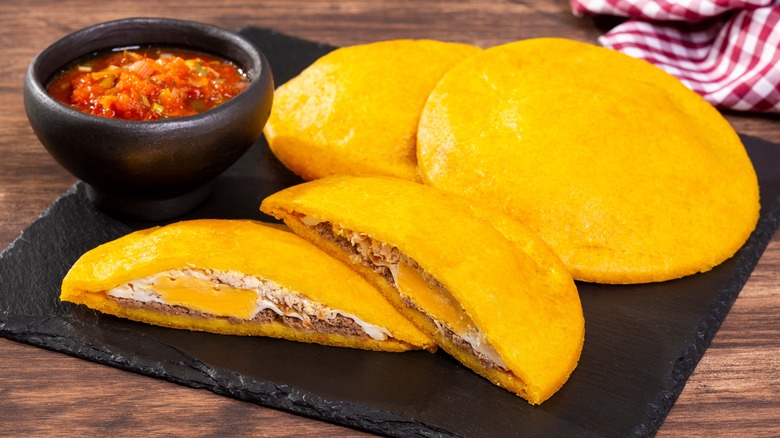Behold The Rare (But Delicious) Charcoal-Cooked Egg
Eggs are a commonplace food item all over the world, particularly when it comes to breakfast. From a nutritional perspective, eggs are an excellent source of protein, vitamins, and nutrients like carotenoids, which support healthy vision by lowering the risk of age-related blindness. Compared to their nutritional value, eggs are also very low in calories. That means they can impart the essential fuel your body needs without negatively impacting your overall wellness.
In addition to their health benefits, eggs are incredibly versatile. While Americans are most accustomed to eating chicken eggs, other countries have a wider range of animals to choose from. Take the greater rhea, for instance, a flightless bird known for being the largest in Argentina. Although the hunting and use of rheas as food products was banned from 1975 until the year 2000, their eggs have become a delicacy in Latin America thanks to special farms that rear the birds in captivity. However, cultures native to the country also collect rhea eggs in the wild, taking care not to harm the bird population by only gathering a certain number.
Rhea eggs can weigh up to 1.4 pounds and are about 3.5 inches wide by 6.3 inches long. Accordingly, rhea eggs can be up to ten times heavier than an average chicken egg. In addition to the surprising size of rhea eggs, they can also be prepared using a seemingly unusual but effective cooking method.
The charcoal-cooked egg technique
If you're ever lucky enough to find yourself with a rhea egg and aren't sure how to prepare it, there's an authentic cooking method you can try. Begin by making a hole in the top of the eggshell just large enough to stick a small implement through, such as a straw. Gently move the straw around inside the shell to ensure the egg white and yolk are properly mixed. Next, add seasonings like parsley, garlic, salt, and pepper to taste. Once everything is mixed, the egg can be relocated to a smoldering mound of charcoal, which should cover the entire bottom half of the rhea egg. After about five minutes on the charcoal, stir the mixture inside the shell. Repeat the cooking and stirring process until the egg appears poached. At this point, the egg can be eaten from the shell or plated and served.
Of course, rheas are just one source of eggs in Latin America. This rich culinary culture also uses eggs from many other birds, including quail and Araucana chickens, which are known for their lack of tails and remarkable, blue-shelled eggs. As for preparation methods, eggs are used in a wide variety of ways, whether scrambled with additional ingredients or added to other dishes, including hot dogs. Of course, this is just a small sampling of the many ways that Latin cuisine incorporates eggs into different recipes.
Other popular Latin American egg cooking methods
When seeking a convenient and hearty meal perfect for breakfast or lunch, arepa de huevo is an awesome selection. Popular in Colombia, this recipe consists of arepas, also known as corn cakes, and fried eggs. After frying corn cakes in oil until fluffy, arepas are sliced to make room for the egg, which is cracked directly inside. A bit of dough is added to keep the egg intact, then the arepa is placed back into the oil and fried again until the egg becomes hard.
If you're looking for something more suitable for dessert, you will enjoy Mexico's jericalla, or light custard. In addition to eggs, the dessert recipe calls for honey, cinnamon, vanilla extract, and low-fat milk. It's similar to flan, another popular egg dessert, but is also comparable to crème brulée (save for the crunchy sugar topping). Even better, this dessert is incredibly easy to make. Milk, vanilla, cinnamon, and honey are boiled in a pot over medium heat, while beaten eggs are gradually added to the mix while it's still boiling. From here, portions of the custard are poured into individual ramekins, which then go into a water bath to be baked. These recipes show that eggs are the perfect ingredient for all types of dishes, both savory and sweet.


